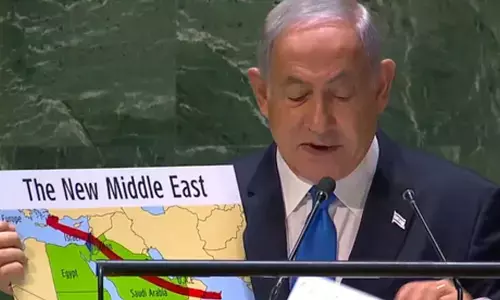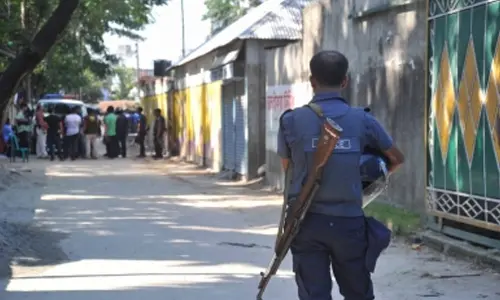A first-hand account of 3-decade-old Ayodhya movement

A first-hand account of 3-decade-old Ayodhya movement
A week is a long time in politics, is a famous quote of British Prime Minister Harold Wilson. If a week is a long time, then 30,786 weeks must be like an eternity.
A week is a long time in politics, is a famous quote of British Prime Minister Harold Wilson. If a week is a long time, then 30,786 weeks must be like an eternity. That is the distance in time Bharat has travelled ever since Moghul invader Babar destroyed the temple that stood on the birthplace of Lord Ram in the holy temple-town of Ayodhya and the Bhoomi Poojan that is scheduled to take place on 5 August 2020.
When Prime Minister Narendra Modi leads a battery of leaders belonging to the Hindu movement to lay the foundation stone on August 5 for the construction of a grand temple befitting the stature of Lord Ram at Ayodhya, history will be in the making. An injustice that was done in 1528 is being undone in 2020. It is nothing but an epoch-making and momentous event in the life of all those who believe and feel proud that Lord Ram is our ancestor.
As I sat glued to the TV watching the announcement made by Ram Janmabhoomi Nyas Trust that the ground breaking ceremony would be held on August 5, I could not control tears rolling down from my eyes. I was a living witness as well as a participant in the three-decade of Ayodhya-related movements and now I am a living witness to the history in the making.
For someone like me who have participated in all the four Rath Yatras and present in two of the three Karsevas at the holy temple-town of Ayodhya related to the Sri Ram temple movement, 5 August 2020 will be an emotionally memorable day.
I am not aware if the Supreme Court consciously decided to pronounce its verdict in this centuries-old dispute on 9th November 2019. Call it irony or coincidence, it was on this day three-decades ago, 9 November 1989 the first Karseva was performed in Ayodhya. The foundation stone was laid for the construction of a grand temple befitting the stature and personality of Lord Ram.
The four yatras that were taken out starting 1986 to rekindle the spirit of cultural nationalism and awaken the Hindus to realise their cultural ethos as well as remember their national hero Lord Ram were – (a) Sri Ram Janaki Rath Yatra; (b) Sri Ram Jyoti Rath Yatra; (c) Sri Ram Shila Rath Yatra and (d) 10,000 Kms Somnath-Ayodhya Rath Yatra undertaken by the then BJP President LK Advani.
While I took part in the first three yatras in various parts of Karnataka, I was part of the Somnath-Ayodhya Advani's Rath Yatra for about 6,000-Kms. I was fortunate to have travelled in the States of Maharashtra, Karnataka, Andhra Pradesh, Madhya Pradesh, Rajasthan, Haryana, Delhi and some parts of Bihar.
Just before the commencement of the Somnath-Ayodhya Rath Yatra, I was sitting with Karnataka Kesari Late Jagannath Rao Joshi, in my capacity as his Sahayak at Kaushik Ashram in Pune, Maharashtra. When the decision was made known to Jagannath Rao Joshi that Advani was going on Rath Yatra, he said spontaneously, "Advani is going to be the man who will lay a strong foundation to guide the course of India's destiny to occupy its rightful place of Vishwa Guru in the comity of nations". Karnataka Kesari Jagannath Rao Joshi is no more today. He passed away in July 1991. But he has proved to be prophetic. He asked me to take part in the Rath Yatra and keep reporting on daily basis over phone.
This "biggest mass movement ever the country has seen since Independence – as Advani prefers to put it - began on September 25 1990 from Somnath in Gujarat and abruptly ended on October 23 when Advani was arrested at Samastipur, Bihar. I was present at Samastipur when Advani was arrested and taken away by the District Magistrate to Masanjore Dam Guest House near Dumka on Bihar-Bengal border to be kept as detainee for the next fortnight.
The choice of Somnath to launch the Rath Yatra for mobilising solidarity of the people is just not casual or accidental. It was a conscious decision taken by Advani. By choosing Somnath as the point where his Rath Yatra starts, Advani sent out a message that it is high time for the government to "emulate Sardar Vallabhbhai Patel" on Ayodhya.
The alliterative slogan – "Sardar & Somnath; Advani & Ayodhya" reverberated throughout the country. Advani also penned a small handbook titled "A Tale of Two Temples" thus highlighting the scant disregard shown to Ayodhya while Sardar Patel demonstrated exemplary courage and political will to re-build Somnath temple.
The reverence that the people have for Lord Ram is only to be seen to believe. Millions who thronged various Rath Yatras actually wanted to touch the tyre, the vehicle and the people manning Rath Yatras. Advani's public meetings were attended by lakhs. In fact, at Jaipur (Rajasthan) and Mandsaur (Madhya Pradesh), the crowd was to the tune of about five to seven lakhs. And they heard Advani in rapt attention.
Advani brought out five dimensions of the Ayodhya movement.
1) Philosophical (that Ram Janmabhoomi is axiomatic – self-evident – as millions of Hindus since time immemorial believe that Ram was indeed born there and hence a grand temple is a must.
2) Historical (that Ram may not be a God to many, but he can still be our national hero, our proud ancestor and hence Indians irrespective of their religious denomination need to identify with Ram and not with Babar. Ram is a native India and Babur was a foreign invader. It is wrong to say that Muslims will identify with Babur. Advani also argued that the government must emulate Sardar Patel.)
3) Ideological (that Ayodhya is essentially an issue of cultural nationalism that has tremendous potential to cement the Hindu-Muslim relationship if handled rightly).
4) Political (that the Ayodhya issue was politicised by constituting Babri Masjid Action Committee and used as a symbol of secularism. But Advani demolished this argument by saying that it was actually pseudo-secularism that was practised by most of the non-BJP parties. His argument that secularism had become a euphemism to show their hate against Hinduism caught the imagination of the people).
5) Legal (that the issue is not to find out whether Ram was indeed born there or not. The issue was whether any temple preceded the mosque; whether any temple was demolished and upon which a mosque constructed? Advani said this can be ascertained by the Archeological Survey of India (ASI) excavations which commenced in 2002 when he was the Deputy Prime Minister of India. The Allahabad Court too had said something similar.
I regret for not being present at Ayodhya during Karseva 2 on October 30, 1990 when hundreds of Karsevaks were shot dead by the trigger-happy Mulayam Singh government. But I was fortunate to have been present in Ayodhya in my capacity as journalist belonging to Rashtriya Sahara in Karseva 3 on 6th December 1992.
How come such a huge structure fell at the hands of karsevaks who never had any sophisticated tools?
The secret was told to me by a former official of ASI in January 1993. He said, "The mosque was a superficial structure. The mosque never had a foundation of its own. It was constructed on the pillars that belonged to a temple. But it will be made known to the world, perhaps, after about a quarter century or so," The Supreme Court said something similar in its judgement which it delivered on 9th November 2019.
Advani's Rath Yatra was a major watershed in the political history of Independent India. It was a much-needed cutting edge that set right the cultural compass of the country. I feel happy that I am a living witness to the history in the making. Welcome Lord Ram, to your rightful place!














